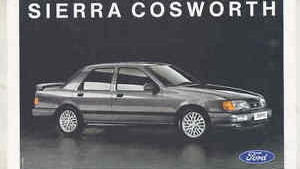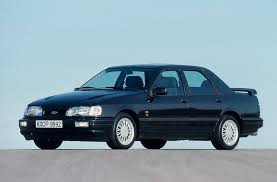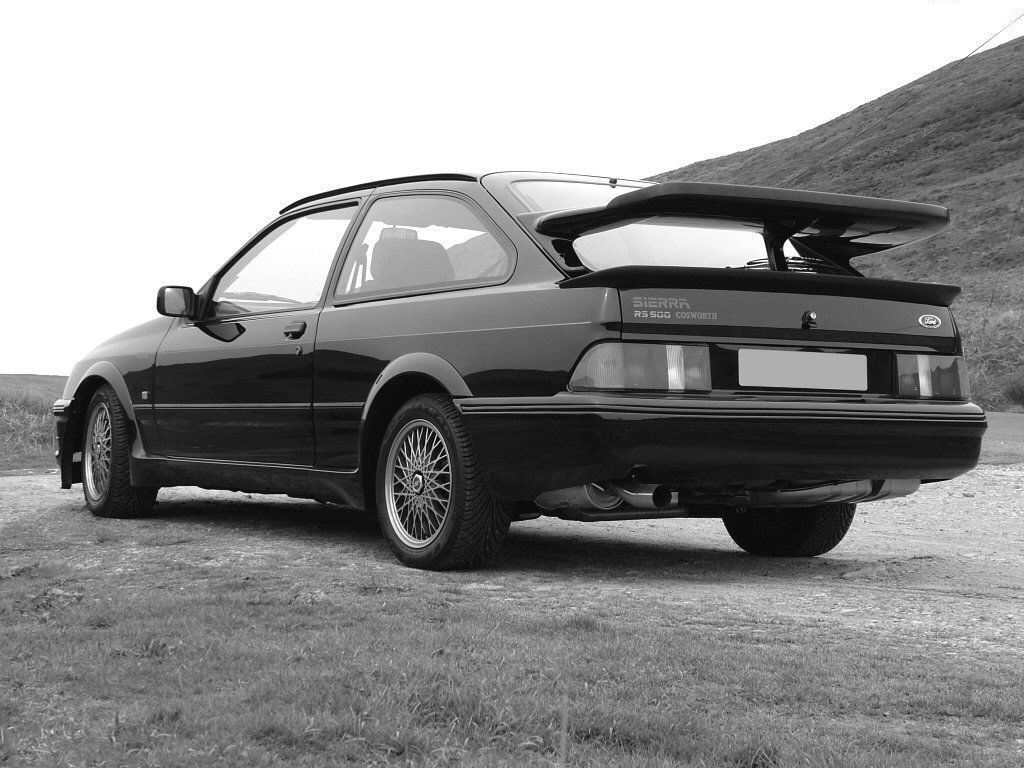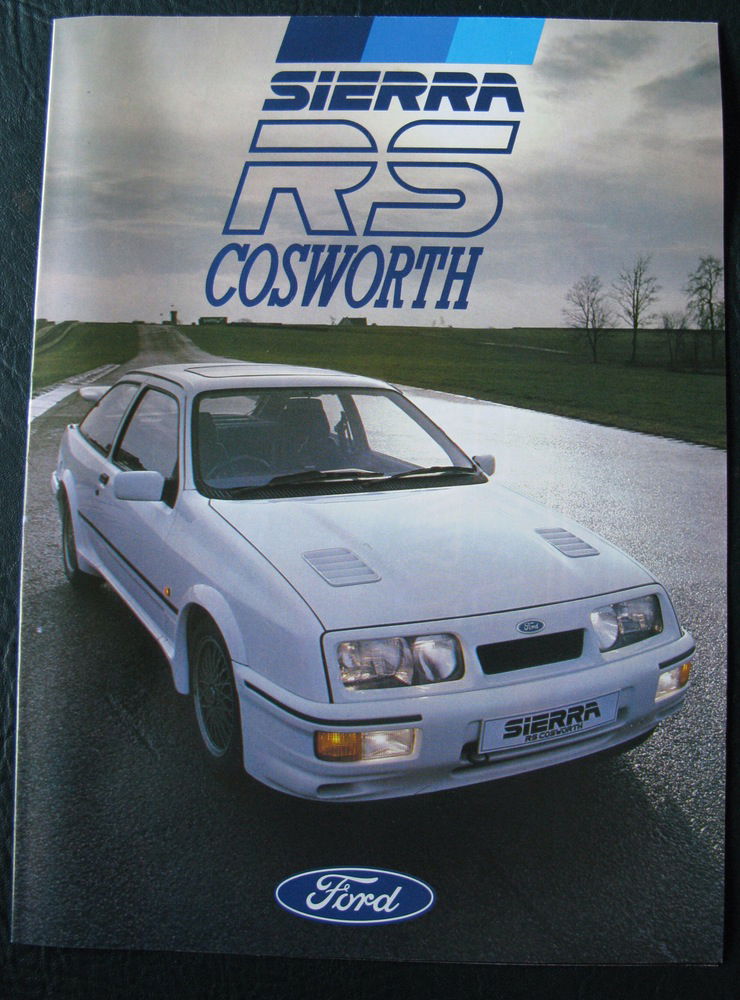The Ford Sierra Cosworth---Fast, Successful In Motorsport, And Oh, Do I Dream Of Having One....
In lieu of the ‘New’ Focus RS(Its a few months old already, I know), I’ve found the time and confidence to cover this car—-The Sierra Cosworth. A car I love, I want, and dream of having. I’m sure many others do, just like me.And, Just Look AT That Wing….

In lieu of the ‘New’ Focus RS(Its a few months old already, I know), I’ve found the time and confidence to cover this car—-The Sierra Cosworth. A car I love, I want, and dream of having. I’m sure many others do, just like me.And, Just Look AT That Wing…. First up, its History.
It was 1983, and Stuart Turner, who had just been appointed head of Ford Motorsport in Europe, suddenly thought that Ford was no longer competitive in Motorsport, and then set out to devise a new, Motorsport-bred car. He first rang up Walter Hayes, at the time Vice-President of Public Relations at Ford, who was also the driving force behind the famed GT40 that won Le Mans in ‘66 and the Cosworth DFV engine that brought Ford 154 victories and 12 World Championships in Formula One during the ‘60’s and ‘70’s. Hayes found the project very appealing and promised to give his full support.Turner then invited Ken Kohrs, vice-president of development, to visit Ford’s longtime partner, Cosworth, where they were presented a project developed on Cosworth’s own initiative, the YAA engine. This was a twin cam, 16-valve engine based on Ford’s own T88 engine block, better known as the Pinto. This prototype proved an almost ideal basis for the engine Turner needed to power his Group A winner.
Therefore, an official request for a turbocharged version (designated Cosworth YBB) capable of 180 hp on the street and 300 hp in race trim, was placed. Cosworth answered positively, but they put up two conditions: the engine would produce not less than 204 hp in the street version, and Ford had to accept no fewer than 15,000 engines. Turner’s project would only need about 5,000 engines, but Ford nevertheless accepted the conditions. The extra 10,000 engines would later become one of the reasons Ford also chose to develop a four door, second generation Sierra RS Cosworth.
Afterwards, they had to find a gearbox…They used the Borg-Warner T5 from the Mustang(Of the time), but the higher revving nature of the Sierra forced Borg-Warner to set up a special production line for the gearboxes going into the Cossies.
Many of the suspension differences between the standard Sierra and the Cossie attributed their development to what was learned from racing the turbocharged Jack Roush IMSA Merkur XR4Ti in America and Andy Rouse’s successful campaign of the 1985 British Saloon Car Championship. Much of Ford’s external documentation for customer race preparation indicated “developed for the XR4Ti” when describing parts that were Sierra Cosworth specific. Roush’s suspension and aerodynamics engineering for the IMSA cars was excellent feedback for Ford. Some production parts from the XR4Ti made their way into the Cosworth such as the speedometer with integral boost gauge and the motorsport 909 chassis stiffening plates.
In April 1983, Turner’s team decided on the Sierra as a basis for their project. The Sierra filled the requirements for rear wheel drive and decent aerodynamic drag. A racing version could also help to improve the unfortunate, and somewhat undeserved, reputation that Sierra had earned since the introduction in 1982.
Lothar Pinske, responsible for the car’s bodywork, demanded ‘carte blanche’ when it came to appearance in order to make the car stable at high speed. Experience had shown that the Sierra hatchback body generated significant aerodynamic lift even at relatively moderate speed. As a result, the famed Whale-Tail that was also fitted to the Sierra’s Successor, the Escort Cossie, a car which Clarkson owned once, was demanded.
Of course, even after that, it still wasn’t completely smooth-sailing.In 1984, Walter Hayes paid visits to many European Ford dealers in order to survey the sales potential for the Sierra. A requirement for participation in Group A was that 5,000 cars were built and sold. The feedback wasn’t any bit encouraging. The dealers estimated they could sell approximately 1,500 cars.
That didn’t stop Hayes, however, and he continued his passionate internal marketing of the project. As prototypes started to emerge, dealers were invited to test drive sessions, and this increased the enthusiasm for the new car. In addition, Ford took some radical measures to reduce the price on the car. As an example, the car was only offered in three exterior colours (black, white and moonstone blue) and one interior colour (grey). There were also just two equipment options: with or without central locking and electric window lifts.

The completed car was first shown to the public at the ‘85 Geneva Motor Show, with plans to release it at the end of September and closing production of the 5000 cars in ‘86, the next year.
In practice, the Cossie was released in July ‘86,and 5545 were manufactured in total of which 500 were sent to Tickford for conversion to the Sierra three-door RS500 Cosworth. The vehicles were manufactured in right hand drive (RHD) only, and were made in Ford’s Genk factory in Belgium.
Now, we get into the specs of the car. The 2.0 Turbocharged I4 Cosworth YBB Engine shoved into the hood produced ‘In Excess Of 204 bhp’, topped out at 149 mph, hit 60 mph in 6.5 s, did 38.2 mpg at 56 mph, 30.1 at 75, as claimed by the brochure, the Whale-Tail produced 20kgf at 150 mph, basically the car’s top speed, had Disc Diameter 28.3 cm brakes on the front, and 27.3 cm brakes on the back, had a ‘Viscous Coupled Slipped Diff’, ran on 205/50 VR x 15, And had 15” x 7” rims.
And, as wanted, it achieved a lot in Motorsport. It essentially won all of this.And this was only On Tarmac.
Series Wins by the Sierra Cossie RS500:
Australian Touring Car Championship - 1988, 1989
Deutsche Tourenwagen Meisterschaft - 1988
Japanese Touring Car Championship - 1988, 1989
AMSCAR series - 1988, 1989, 1990
Nissan Mobil 500 Series - 1989, 1990
New Zealand Touring Car Championship - 1989, 1990, 1992
British Touring Car Championship - 1990
Australian Endurance Championship - 1990
Race Wins
Wellington 500 - 1987
Fuji InterTEC 500 - 1987, 1988, 1989
RAC Tourist Trophy - 1988
Sandown 500 - 1988, 1990
Bathurst 1000 - 1988, 1989
Pukekohe 500 - 1988, 1989, 1990
Spa 24 Hours - 1989
Guia Race of Macau - 1989
Then, it was also entered into rallying…
The Sierra Cosworth was also pressed into service as a rally car, and saw some success. After the abolition of the Group B formula in the World Rally Championship at the end of 1986, manufacturers had to turn to Group A cars and Ford, like most others, found itself without a fully suitable car. The Cosworth was very powerful but, with only rear-wheel-drive, lost out to the four-wheel-drive Lancias and Mazdas on loose-surface events, while the four-wheel-drive XR4x4 had an excellent chassis but an elderly engine producing only around 200 bhp, at least 100 less than the Lancia. For the 1987 season the team ran both, using the XR4x4 on loose surfaces and the Cosworth on tarmac, but the XR4x4’s power disadvantage was too great and from 1988 the team concentrated on the Cosworth alone, and continued to use it until the arrival of the Sierra RS Cosworth 4x4 in 1990.
The rear-drive car never won a loose-surface World Rally Championship event, but in the hands of drivers such as Stig Blomqvist, Carlos Sainz and Ari Vatanen(The driver of the 205 T16 and the 405 T16 PP) it frequently finished in the top five, except when conditions were particularly slippery. On tarmac it was a much more serious competitor, and a young Didier Auriol won the 1988 Corsica Rally outright, the only time that season that Lancia were beaten in a straight fight. However, as Lancia developed the Delta Integrale further and new cars such as the Toyota Celica GT-Four ST165 appeared, the Cosworth became steadily less competitive.
Thanks to strong support and readily available parts from Ford Motorsport, the Cosworth was a popular car with private teams. Moreover, below world championship level, four-wheel-drive opposition was limited at the time, and the Cosworth was as fast as any of its two-wheel-drive rivals. It lacked the fine handling of the BMW M3, for example, but on the other hand it was much more powerful. It was also very reliable. Consequently it became a very popular car at national championship level, and during the late 1980s Sierra drivers won many national series. Jimmy McRae took the British Rally Championship in a Sierra in 1987 and 1988, whilst Carlos Sainz won the Spanish Championship in the same years, to name but two. The Cosworth was popular with spectators because it was visually dramatic, with its flame-spitting exhaust and tail-sliding, rear-drive handling; and it was popular with amateur drivers because it was competitive, robust and relatively cheap. To this day it is a fairly common sight on lower-level events.

Now, we move on to the Sierra Cossie 4x4 and the Sierra Sapphire. We’ll start with the Sapphire first. Essentially, its nearly the same as the Sierra which it’s based on, except, as shown from the picture above, it has 4-Doors instead of 3(Driver and Passenger, and then Hatch). The car was also assembled at the Genk Factory in Belgium.Cylinder heads on this car were early spec 2wd heads and also the “later” 2wd head which had some improvements which made their way to the 4X4 head. Suspension was essentially the same with some minor changes in geometry to suit a less aggressive driving style and favour ride over handling. Spindles, wheel offset and other changes were responsible for this effect. Approximately 13,140 examples were produced during 1988-1989 and were the most numerous and lightest of all Sierra Cosworth models. Specifically the LHD models which saved weight with a lesser trim level such as roll up rear windows, no air conditioning etc.
In the UK, the RHD 1988-1989 Sierra Sapphire RS Cosworth is badged as such with a small “Sapphire” badge on the rear door window trims. All 1988-1989 LHD models are badged and registered as a Sierra RS Cosworth with no Sapphire nomenclature at all. “Sapphire” being viewed as a Ghia trim level that saw power rear windows, air conditioning and other minor options. Enthusiasts of the marque are mindful of this and will describe the LHD cars by their body shell configuration, 3 door or 4 door. Example: 4 door Sierra RS Cosworth.
The Sapphire Cosworth, being based on a different shell to the original three-door Cosworth, along with its more discreet rear wing, recorded a drag co-efficient of 0.33, thus allowing it to register slightly better performance figures (top speed of 150 mph and 0-60 in 6.1 seconds) compared to the original Cosworth. And since it has 4-doors, its Waay more practical, and faster and more discreet than the Cossie, SCORE! That is, if you don’t want to be noticed…The 3-Door Cossie with the Whale-Tail wing you could hold a state banquet is more iconic and desired, though.
And now, the 4x4.

Okay, first off, this is LEGITIMATELY how the Sierra Cossie 4x4 Looks like. The obvious difference? No Whale-Tail you can hold a state banquet on. Also, its based on the Sapphire Cossie body..
In January 1990 the Third-Gen Sierra RS Cosworth was launched, this time with Four-Wheel-Drive. As early as 1987, Mike Moreton and Ford Motorsport had been talking about a four wheel drive Sierra RS Cosworth that could make Ford competitive in the World Rally Championship. The Ferguson MT75 gearbox that was considered an essential part of the project wasn’t available until late 1989 however.
Ford Motorsport’s desire for a 3-door “Motorsport Special” equivalent to the original Sierra RS Cosworth was not embraced. The more discreet 4-door version was considered to have a better market potential. It was therefore decided that the new car should be a natural development of the second generation, to be launched in conjunction with the face lift scheduled for the entire Sierra line in 1990.
The waiting time gave Ford Motorsport a good opportunity to conduct extensive testing and demand improvements. One example was the return of the bonnet louvers. According to Ford’s publicity material, 80% of the engine parts were also modified. The improved engine was designated YBJ for cars without a catalyst and YBG for cars with a catalyst. The latter had the red valve cover replaced by a green one, to emphasize the environmental friendliness. Four wheel drive and an increasing amount of equipment had raised the weight by 100 kg, and the power was therefore increased to just about compensate for this.I haven’t a clue how much power the car produces, but no one cares, really. We just care that it’s a Cossie. Goodness Gracious, I forgot the RS500! Well, time to finish the RS500…

Okay, the RS500. If you remember what I mentioned earlier about 500 cars going somewhere else before heading to dealers and happy owners, this is what became of them.
Mike Moreton was head of the team that planned to develop an evolution edition aimed at making the car unbeatable on the race tracks. In March 1987, Aston Martin Tickford was signed for the job of converting the 500 cars.
The Cosworth RS500 was announced in July 1987 and was homologated in August 1987.
The main difference to the Sierra three-door Cosworth was the uprated Cosworth competition engine. Its new features were:
The engine had a thicker walled cylinder block to cope with the rigours of the track
A larger Garrett T04 turbocharger
A larger air-air intercooler
A second set of four fuel injectors and a second fuel rail (unused in the roadgoing version)
An uprated fuel pump
A reworked induction system to allow higher power outputs to be realised
An uprated oil and cooling system
The rear semi-trailing arm beam had extended but unused mounting points
The RS500 also had minor external cosmetic differences to its parent the Sierra three-door Cosworth:
The rear tail gate had a lower spoiler in addition to the upper “whale tail”, which had an added lip
Discreet RS500 badges on the rear tail gate and front wings
A redesigned front bumper and spoiler to aid cooling and air flow, including the removal of the fog lamps and their replacement with intake grilles to supplement brake cooling.
Exactly 500 RS500s were produced, all of them RHD for sale in the UK only - the biggest market for this kind of Ford. It was originally intended that all 500 would be black, but in practice 56 white and 52 moonstone blue cars were produced.

To conclude, this car is one of the automotive greats, alongside its successor the Escort Cossie, and the Escort Mk1, R32, and so many others. It’s fast, just about practical enough to drive anywhere and everywhere, really valuable, and one of my favorite Fords. Heck, make that my favorite one, actually. In case your’re wondering about prices for these things now, having had a quick look on carsandclassic.com.uk, these things are now fetching anywhere from 4000 pounds(For a Sapphire Project Car with no engine), to anywhere over 60 grand for some. Expensive, even more expensive than the Carlton I started my Article Career on….Still, that won’t stop us from trying to get the funds for one, now will it? This might be a good time to ring up Hitachi Personal Finance….
Hope you enjoyed this article, I had a whale of a time doing this, and feel free to comment down below ideas and ways I can improve.
And on THAT bombshell, you have just finished reading my article on the Sierra Cosworth. See you at the next one.
Comments
Nice!
Bruh
Dude, this deserves more upvotes
This post is awesome. Well worth the upvote I gave it.
MattRobinson
Very well written reader review. Where did your info come from out of curiosity?
Theres a saphirre local to me the wheels have been taken of for safety but it is in good shape, its damn beautiful
Meet
Hi,
Htanks for the article, very nice read!
Now it’s time to make one about the Minker :D
This was a superb article, I also just bought a ‘91 Sierra 2.0 dohc a couple of days ago, trying to find an LSD for it right now. I mainly bought it for drifting/ winterbeater.
Pagination